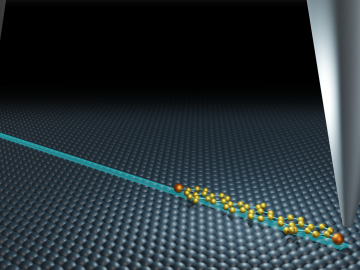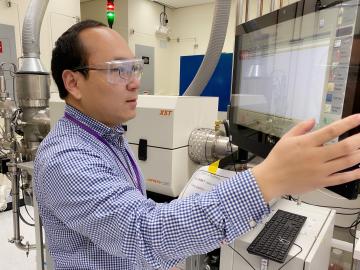
Filter News
Area of Research
- (-) Materials (76)
- (-) Materials for Computing (12)
- (-) Nuclear Science and Technology (40)
- Advanced Manufacturing (4)
- Biological Systems (1)
- Biology and Environment (29)
- Computational Biology (2)
- Computational Engineering (1)
- Computer Science (1)
- Energy Science (42)
- Fuel Cycle Science and Technology (1)
- Fusion and Fission (30)
- Fusion Energy (10)
- Isotope Development and Production (1)
- Isotopes (28)
- National Security (32)
- Neutron Science (25)
- Nuclear Systems Modeling, Simulation and Validation (1)
- Quantum information Science (4)
- Sensors and Controls (1)
- Supercomputing (45)
News Topics
- (-) Biomedical (10)
- (-) Cybersecurity (5)
- (-) Isotopes (17)
- (-) Microscopy (31)
- (-) Molten Salt (7)
- (-) Nuclear Energy (49)
- (-) Polymers (23)
- (-) Security (3)
- (-) Space Exploration (8)
- 3-D Printing/Advanced Manufacturing (30)
- Advanced Reactors (14)
- Artificial Intelligence (9)
- Big Data (2)
- Bioenergy (13)
- Biology (5)
- Buildings (5)
- Chemical Sciences (36)
- Clean Water (3)
- Composites (10)
- Computer Science (26)
- Coronavirus (8)
- Critical Materials (13)
- Energy Storage (38)
- Environment (17)
- Exascale Computing (2)
- Frontier (3)
- Fusion (15)
- Grid (5)
- High-Performance Computing (4)
- Irradiation (1)
- ITER (1)
- Machine Learning (5)
- Materials (83)
- Materials Science (94)
- Mathematics (1)
- Nanotechnology (46)
- National Security (4)
- Neutron Science (43)
- Partnerships (11)
- Physics (30)
- Quantum Computing (4)
- Quantum Science (14)
- Simulation (2)
- Summit (3)
- Transportation (19)
Media Contacts

When COVID-19 was declared a pandemic in March 2020, Oak Ridge National Laboratory’s Parans Paranthaman suddenly found himself working from home like millions of others.

On Feb. 18, the world will be watching as NASA’s Perseverance rover makes its final descent into Jezero Crater on the surface of Mars. Mars 2020 is the first NASA mission that uses plutonium-238 produced at the Department of Energy’s Oak Ridge National Laboratory.


Oak Ridge National Laboratory’s Center for Nanophase Materials Sciences contributed to a groundbreaking experiment published in Science that tracks the real-time transport of individual molecules.

Six scientists at the Department of Energy’s Oak Ridge National Laboratory were named Battelle Distinguished Inventors, in recognition of obtaining 14 or more patents during their careers at the lab.

Scientists at Oak Ridge National Laboratory and the University of Tennessee designed and demonstrated a method to make carbon-based materials that can be used as electrodes compatible with a specific semiconductor circuitry.

Four research teams from the Department of Energy’s Oak Ridge National Laboratory and their technologies have received 2020 R&D 100 Awards.

About 60 years ago, scientists discovered that a certain rare earth metal-hydrogen mixture, yttrium, could be the ideal moderator to go inside small, gas-cooled nuclear reactors.

Radioactive isotopes power some of NASA’s best-known spacecraft. But predicting how radiation emitted from these isotopes might affect nearby materials is tricky

Researchers at ORNL used quantum optics to advance state-of-the-art microscopy and illuminate a path to detecting material properties with greater sensitivity than is possible with traditional tools.


